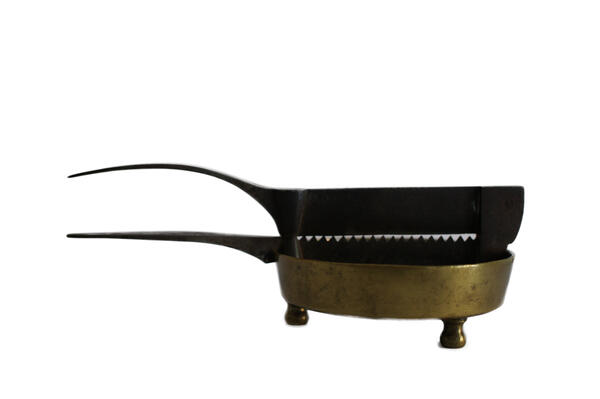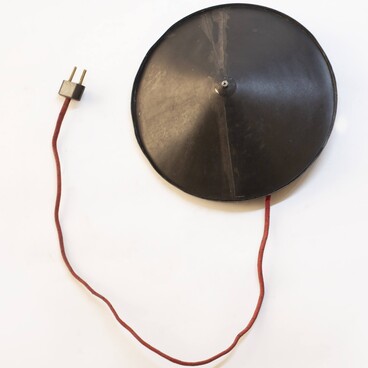Sugar nips or sugar cutters were used to break large pieces of refined sugar into small ones suitable for tea drinking or storing sugar in a bowl. In the 19th — early 20th century, such kitchen utensils were very common.
At that time, sugar was made in the form of so-called loafs. Thick molten sugar syrup — called utfel in Russian — was poured into cone-shaped molds, in which it dried and crystallized for several weeks. Then it was taken out, the base was wrapped in traditional blue paper — it was also called sugar paper. Then the loafs of different sizes went on sale. Since they were quite large, it was necessary to break off smaller pieces for tea drinking.
For this purpose, pairs of pincers of different types were used. Some were intended for breaking the sugarloaf into pieces and others were simple sugar tongs for picking up sugar pieces. There were also larger sugar nips with drawers for storing sweets.
The exhibit from the Pavel Petrovich Bazhov House-Museum is unusual in its design, specifically in the presence of a round pallet, which makes the sugar nips look like a small frying pan. There are no stamps or other identification marks on the item, so it is not known where and when it was made. In the writer’s family, it was used for a long time; according to the memoirs of some family members, these peculiar sugar nips were produced by workers of one of the local Ural factories.
At dinnertime, the whole large family of Pavel Petrovich gathered in the dining room, and they always waited for the writer: no one touched the food until he came in. Bazhov and his wife sat opposite each other: the hostess at the samovar, and the owner at the opposite end of the table.
People who visited the house during the Great Patriotic War recalled that the Bazhovs often drank carrot “tea”, that is, brewed grated dried carrots. This was a way to save money, as the family could not always afford real Chinese or Indian tea. The drink was consumed together with small pieces of sugar broken with the sugar nips; the sugar replaced sweets. Another method of tea drinking included holding a piece of sugar between the teeth and drinking tea through it.
Bazhov’s house was a very popular place in the city: there the writer received petitioners (as he was a deputy of the Supreme Soviet of the USSR), aspiring authors who came to him for advice, numerous fellow writers, close friends and acquaintances. It was considered obligatory in the family to first give the guests their tea, and only afterward to work and negotiate with them.
At that time, sugar was made in the form of so-called loafs. Thick molten sugar syrup — called utfel in Russian — was poured into cone-shaped molds, in which it dried and crystallized for several weeks. Then it was taken out, the base was wrapped in traditional blue paper — it was also called sugar paper. Then the loafs of different sizes went on sale. Since they were quite large, it was necessary to break off smaller pieces for tea drinking.
For this purpose, pairs of pincers of different types were used. Some were intended for breaking the sugarloaf into pieces and others were simple sugar tongs for picking up sugar pieces. There were also larger sugar nips with drawers for storing sweets.
The exhibit from the Pavel Petrovich Bazhov House-Museum is unusual in its design, specifically in the presence of a round pallet, which makes the sugar nips look like a small frying pan. There are no stamps or other identification marks on the item, so it is not known where and when it was made. In the writer’s family, it was used for a long time; according to the memoirs of some family members, these peculiar sugar nips were produced by workers of one of the local Ural factories.
At dinnertime, the whole large family of Pavel Petrovich gathered in the dining room, and they always waited for the writer: no one touched the food until he came in. Bazhov and his wife sat opposite each other: the hostess at the samovar, and the owner at the opposite end of the table.
People who visited the house during the Great Patriotic War recalled that the Bazhovs often drank carrot “tea”, that is, brewed grated dried carrots. This was a way to save money, as the family could not always afford real Chinese or Indian tea. The drink was consumed together with small pieces of sugar broken with the sugar nips; the sugar replaced sweets. Another method of tea drinking included holding a piece of sugar between the teeth and drinking tea through it.
Bazhov’s house was a very popular place in the city: there the writer received petitioners (as he was a deputy of the Supreme Soviet of the USSR), aspiring authors who came to him for advice, numerous fellow writers, close friends and acquaintances. It was considered obligatory in the family to first give the guests their tea, and only afterward to work and negotiate with them.




